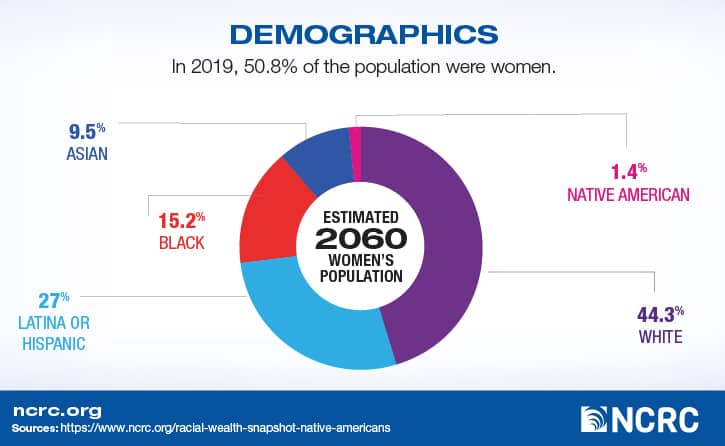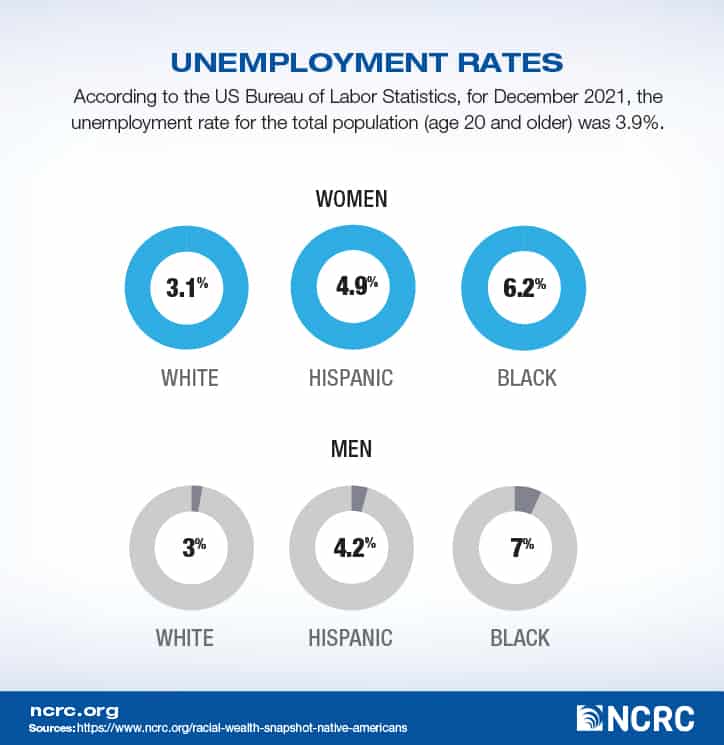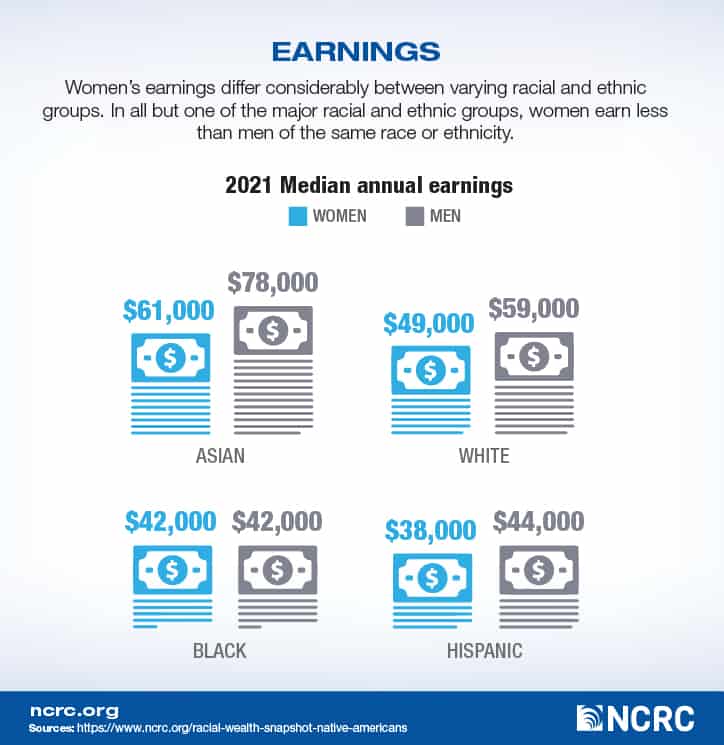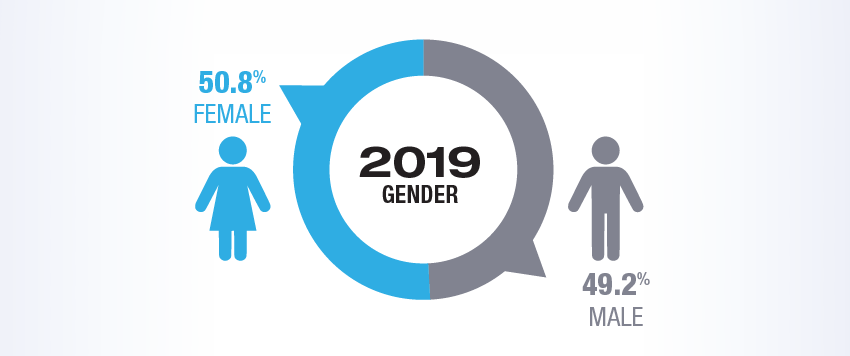See more here.
Introduction
Women have made great strides in the workplace, comprising nearly half of the workforce and surpassing men in higher education achievement. Yet women still earn less income, have less wealth and face greater economic instability than their male counterparts. The economic instability men and women face is profoundly influenced by racial economic inequality. This snapshot will briefly review the socio-economic differences between men and women and highlight how those differences intersect with racial and ethnic disparities in the United States.
Demographics
In 2019, 50.8% of the population were women, of which 60% were White, 18% were Latina or Hispanic, 12.9% Black, 5% Asian, and 0.7% Native American. The estimated population for women of color is expected to grow. The US Census Bureau projects that by 2060, 44.3% of women will be White, 27% Hispanic or Latina, 15.2% Black, 9.5% Asian, and 1.4% Native American.

Labor Participation & Unemployment
Over the last 50 years, there has been a steady increase in labor participation for women across the largest racial and ethnic categories. Women’s labor participation rates hit a high of almost 60% in the 2000s. In fact, as of January 2020, women accounted for the majority of the American workforce for only the second time in history – and the first in peacetime – standing at 50.04% of all payroll workers. Men have been experiencing a substantive decrease in labor participation, recently hitting a low of 66%. Since the mid-70s, Black and White men saw an 8% decline in labor participation while Latino men saw a decrease of half of that at 4%.
Conversely, Black, Latina and White women have experienced similar increases in labor force participation rates since the mid-70s, increasing about 15%. During this near 50-year period, Black women have been the leaders among women in labor force participation, with rates ranging from 53% to 66%. Both Black and White women saw the height of their labor force participation rate in 2000, with a gradual decline for both groups until the 2020 COVID-19 pandemic brought a more dramatic drop. In light of the COVID-19 pandemic, women and men have seen similar workforce declines. Approximately 17% of women in the sample either lost their job or were told not to work due to the ongoing COVID-19 pandemic, compared to 15% of men. This also holds for those who took unpaid leave, with women accounting for 16% to men’s 15%. The decline in labor participation has been the reality for both men and women since post the Great Recession, only exacerbated by the pandemic.

Interestingly, labor force participation does not cleanly correspond with economic well-being, particularly when looking at labor force participation for men and women. For example, both Black men and women are generally much more economically insecure than White men and women. Yet Black men have lower labor participation rates than White men, and Black women have higher participation rates than White women. Latinos and Latinas have higher labor participation rates than White men and women, yet are economically much more similar to Blacks with lower income and lower wealth.
It is also interesting to note that gender equality in labor participation is not a sign of economic well-being. While Blacks have the lowest gap between men and women in labor force participation at 4.9% as of 2020, they are still the most economically insecure large racial group. Latinos have the largest gender labor participation gap of 20.3%, but have similar economic standing to Blacks. Asians have the second-highest gender labor participation gap of 16.3%, followed by Whites at 13.5%. Though labor participation is not a clear indicator of economic well-being, there is a correspondence between economic well-being and unemployment.
Unemployment measures the percentage of those in the labor force actively seeking work. According to the U.S. Bureau of Labor Statistics, for December of 2021, unemployment rates for the total population (age 20 and older) was 3.9%, down from 6.7% in December 2020. Although everyone is feeling the economic pressures of the pandemic, people of color are facing higher unemployment rates than White men. At the end of the fourth quarter of 2021, 3.1% of White women were unemployed, compared to 6.2% of Black women and 4.9% of Hispanic women. Comparatively, White men faced a 3% unemployment rate, while the unemployment rate was 7% for Black men and 4.2% for Hispanic men. Disaggregated data for Asian men and women is unavailable, but the Asian unemployment rate is 3.8%. With the limited information we have, Whites were the only group where men have equal unemployment rates with women in their racial group. In contrast, Blacks were the only group where men had higher unemployment rates than women in their racial group.
Earnings
Women’s earnings differ considerably between varying racial and ethnic groups. In all but one of the major racial and ethnic groups, women earn less than men of the same race or ethnicity. The size and nature of this gender disparity varies significantly among racial and ethnic groups. In the fourth quarter of 2021, Asian Americans had the most significant gender income inequality, with a $17,000 annual disparity between men and women. Asian American men have weekly median earnings of $1,499 or about $78,000 over 52 weeks compared to Asian American women making median weekly earnings of $1,165 or $61,000 a year. Among Whites, the income gender disparity over a year is $10,000, with White men making approximately $59,000 and White women making $49,000. The Hispanic gender income disparity was only $6,000, with Hispanic men earning about $44,000 a year and Hispanic women about $38,000.

This gender gap disappears among African Americans. Both African American men and African American women make about $42,000 over 52 weeks. The US Bureau of Labor Statistics did not offer similar data for Native Americans.
Poverty
There are dramatic disparities in poverty rates by racial and ethnic groups and smaller disparities by gender. Men and women of color are more likely to live in poverty than White men and women, whose poverty rates in 2019 were 7% and 9%, respectively. In the same year, the rates of people of color who lived in poverty were 19% for Black men and 23% for Black women, 22% for Native American men and 25% for Native American women, 16% for Hispanic men and 19% for Hispanic women, and 10% for both Asian men and Asian women.
Men, Women, Marital Status, And Wealth
According to 2019 data highlighted by Dr. Mariko Chang, the median wealth for single women was $36,000, while the median wealth for single men was $43,800. Single women held 82 cents of wealth for every dollar of wealth owned by a single man.
African Americans, who in many categories have the greatest gender economic equality, have the greatest gender wealth disparity though still having little wealth compared to Whites. Single Black men’s median wealth was $10,100, compared to Single Black women’s median wealth of $1,700. Single White women have slightly higher median wealth levels than single White men. Single White women’s wealth is estimated at $81,200 compared to single White men at $78,200. Hispanics have the lowest wealth when examining single men and women. Single Hispanic mens’ median wealth was $4,200, compared with single Hispanic womens’ median wealth at $1,000.
Parenthood
While this data from the Asset Funders Network Center is from 2013, it sets a benchmark that highlights racial, ethnic, and gender disparities when accounting for children. The median wealth of single fathers is higher than single childless men’s wealth, while conversely, single mothers’ median wealth is lower than that of single childless women. This points to a widening inequality divide between single fathers and single mothers. The median wealth of single White mothers was $14,600, approximately $1,000 less than that of single White women. Comparatively, single White fathers’ wealth was $41,410, roughly $13,000 more than single White men. The median wealth of Single Hispanic mothers is $50, half the barely-existent $100 median wealth of single Hispanic women overall. The median wealth of single Hispanic fathers is $1,250, slightly higher than the $950 median wealth of single Hispanic men overall. This increase does little to address wealth poverty. The situation is similar among African Americans. Single Black women without children have a median wealth of just $200 – but for single Black mothers that figure drops to $0. Wealth grew from $300 for Black single men overall to a still-low $500 for single Black fathers overall.
Educational Achievement
The majority of Blacks, Hispanics, Native Americans and Whites over the age of 25 are not college graduates. Although there are overall gradual increases in college attainment for all groups, there are still significant disparities. Across the board, women tend to have higher levels of educational attainment despite generally having lower socioeconomic indicators. In the 2015-2016 academic year, White women received 60% of associate’s degrees and 56% of bachelor’s degrees. For Black, Hispanic, and Native American groups, there is a greater disparity in educational achievement between men and women. In the Black community, 67% of associate’s degrees and 64% of bachelor’s degrees were awarded to women. 62% of associate’s degrees and 64% of bachelor’s degrees were awarded to women within the Hispanic community. Similarly, Native American women earned 65% of associate’s degrees and 61% of bachelor’s degrees. Lastly, Asian Americans saw the least gender disparity among the major racial and ethnic groups, where 56% of associate’s degrees and 54% of bachelor’s degrees were awarded to Asian women.

Dedrick Asante-Muhammad is the Chief of Membership, Policy and Equity at NCRC.
Esha Kamra is a former NCRC Membership, Policy, and Equity intern.
Connor Sanchez is an NCRC Membership, Policy and Equity Intern



